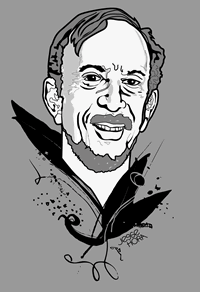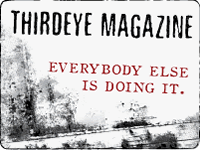
TE: Can you fill us in on the thought process that led to the creation of the Bioneers Conference in 1990?
KA: Well, where to begin… I had a personal health crisis when I was about 19 and it was unable to be helped with conventional medicine. So, out of desperation I turned to alternative healing methods and got some relief. As a result, I became very interested in alternative medicine, had a lot of benefit from using it over many years, and in the course of that I moved to a small farm in New Mexico and learned to grow my own food organically. In the midst of all of this, my father died from cancer at a very young age, and I ended up investigating alternative cancer therapies. I made a feature documentary released in 1987 called, Hoxsey: When Healing Becomes a Crime, about the politics of medicine. It focuses on the Hoxsey treatment, which is basically an herbal treatment that was once very famous in the U.S… What I learned from studying this big conflict between conventional medicine and natural medicine is that what Hoxsey and all the natural medicines were actually saying was: “It’s really nature that heals.” And that, to me, became the underlying philosophical principal for Bioneers, which is this idea of working with nature to heal nature. By imitating nature we can participate in that process and live much better on the planet then the ways that we are now.
Meanwhile, in the middle of doing Hoxsey, I was asked to make a film about a very unusual garden on an Indian pueblo north of Santa Fe, near where I lived. It was there I met Gabriel Howearth, a master gardener who had been traveling all over the Americas studying traditional indigenous farming practices. The peoples with whom he apprenticed gave him what, for them, was the most precious of gifts; the gift of seeds. So Gabriel had planted this incredible arc of biodiverse seeds at this garden in San Juan Pueblo, and although I’d been a little farmer and gardener and all that, I’d never seen anything like this. What I really learned, is that diversity really is the fabric of life. It is what nature uses as a failsafe mechanism against extinction and as a response to change. So Gabriel and I ended up getting together a couple of years later to co-found a company called Seeds of Change.
I was actively seeking out what I came to call Bioneers – biological pioneers who were looking for nature’s operating instructions.
So here was this Hoxsey thing, and while it wasn’t a cure-all or magic bullet for cancer, it was certainly part of a solution, and then here’s this little company Seeds of Change trying to respond to the loss of diversity in our food system, and I realized there must be other people who have looked to nature as a teacher and mentor. And that was really the genesis of the Bioneers conference in 1990. I was actively seeking out what I came to call Bioneers – biological pioneers who were looking for nature’s operating instructions. And that was what the first conference was about; to bring all these people together and start to see what we were learning. From the very beginning my wife and partner Nina Simons co-produced the conference with me, and we’ve been doing it ever since.
TE: What made you decide to do it in California, and what made you feel that the conference type setting, with an array of speakers would best serve your purpose?
KA: Well, I had literally never been to a conference before I started Bioneers, and in a way that was an advantage because I didn’t know what you were supposed to do. So I just created something that was interesting to me, and brought together all these very fascinating and talented people. I liked to learn, so I learned everything I could about their work, and when I introduced them I would give some context about what they are working with or what the problem was that they were solving. So that evolved over many years into a format that’s pretty unusual in the sense that we present a lot of context for speakers, we don’t just throw them up on the stage. And so that has proven to be a good way of going about it. And the first three years of the conference we did hold it in Santa Fe, but each year it just kept growing, and after the third year it was just getting too big. There were no facilities in Santa Fe that could accommodate it, so we moved it to the Bay Area because that is the hotbed of innovative thinking and a lot of brilliant environmental work.
TE: In addition to the Hoxsey treatment and the work of Gabriel Howearth, what spurred you on the path toward advocating the type of change espoused by the Bioneers?
KA: One influence is John Todd who built what he calls living technologies, where he modeled how nature treats waste; because in nature the concept of waste doesn’t even exist. So John used living organisms, microbes and plants, and actually animals – fish and other mammals – to treat sewage, septage, oil waste, and all kinds of other nasty toxic materials. He was a deep, deep influence on me. Another trigger, was that in 1988 James Hansen from NASA testified before congress and talked about global warming. My brother Jesse had been working on global warming for National Academy of Sciences starting in 1976, so when we heard James Hansen’s testimony before congress, we knew. We knew it was coming and we knew it was very, very serious. So I realized we had to start looking for solutions, and that, from day-one, has always been the focus of Bioneers. One dimension of that approach is technological, but that’s not really ultimately going to solve things. My belief – which came to me through being exposed to Native American culture – is the understanding that we are the environment; there is no separation. It’s really about a change of heart on our part, of understanding ourselves as being a part of nature rather than being apart from it. The Biologist E.O. Wilson talks about a word that he came up with called “biophilia,” which is the idea that life has an affinity for life, and that by really appreciating what we love we’re going to save what we love. So a lot of this is about human beings as a species coming back to those original instructions that we’re part of all this. We didn’t invent nature, nature invented us.
TE: Did you ever imagine the conference would grow and evolve the way it has… spawning media outreach programs, a Moving Images Festival, 16 beaming Bioneers conferences around the nation, and a series of books?
Because the whole point to me was not to just keep building a bigger and bigger event, but to actually be like a seed-head and spread it.
KA: To be honest, from the very beginning I envisioned the whole media part of it – the radio series, the book series, reaching out to the press, getting the stuff into the mass media. But what was a complete surprise was the growth of the conference itself, I don’t think I ever imagined how big it would get. And I never ever foresaw the beaming Bioneers program. At the first conference there were all of 200 people – which seemed huge at that time – and I figured these people are all working along the same lines and they must know each other. What I discovered was that hardly anybody knew each other, even if they were working in the same field. And over time the conference became this huge networking event. A lot of interesting cross-pollination occurred and collaborations came from that. And so, I guess six or seven years ago, this person from Toronto came to us and said, “I want to bring this work back to Toronto, can you beam this up by satellite?” It took about a week for it to sink in, and then I said, “That’s a great idea!” Because the whole point to me was not to just keep building a bigger and bigger event, but to actually be like a seed-head and spread it. We all live in a place, and we need to take care of our place. So I loved the idea that we could beam in some of the plenary speakers, but then the people on the ground locally could then adapt it for their own needs.
TE: Was there anything seemingly providential about how all of this developed?
KA: There’s tremendous synchronicity, and if you’re paying attention things are revealing themselves to you right in front of your eyes. Fred Kirschenmann, who’s a very wonderful biodynamic farmer, gave a talk at Bioneers a number of years ago, and he said that farming was really like dancing – sometimes you lead and sometimes you follow. And that’s kind of how I approach the work that we do. Sometime we lead and we say we’re going to go in this direction, and sometimes we just wait to see what events are showing up. Sometimes the Universe speaks and says, “OK you need to go in this direction.” Like with the satellite thing.
TE: What do you feel sets the Bioneers apart from other environmental or social movements?
KA: Well a couple of things. I think number one: the focus on solutions. So much of the environmental movement has been focused on the problems. And that’s important, we’ve got to understand the problems. But at the end of the day, we have to move beyond the problems into solutions, and then we have to move beyond the solutions into action. And so I think that’s one element. To explain the other very fundamental thing about Bioneers, we use this term: “declaration of interdependence.” The understanding that we are a part of the web of life. And therefore, when you really grasp what that means from a biological point of view, what you also realize is that all the issues are connected. There really are not single or separate issues. If there are people who live on two dollars a day or less, we can’t solve the environmental crisis without addressing poverty and inequity in the world. So I think that’s partly what’s very different about Bioneers, is we’re bringing all the pieces together. It’s this fundamental idea that it’s all connected and that we’re all connected.
Pages: 1 2





No Comments so far ↓
There are no comments yet...Kick things off by filling out the form below.